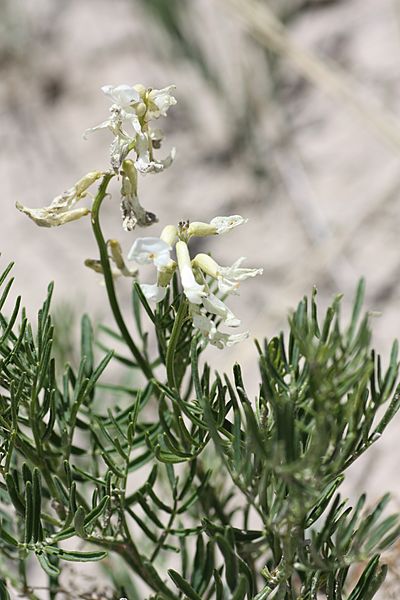Image: Osterhout Milkvetch (5715872143)

Description: Osterhout milkvetch flowers are white and showy to attract pollinators. Photo credit: USFWS ........................................................................... BACKGROUND: The Osterhout milkvetch (Astragalus osterhoutii) and the Penland beardtongue (Penstemon penlandii) are both extremely rare plants endemic to barren white shale outcrops of the Niobrara Shale and Troublesome Formations in Grand County of northern Colorado. Both species are only found near the Town of Kremmling in “Middle Park,” a high elevation sagebrush park at 7,500 feet surrounded by various ranges of the Rocky Mountains in Grand County, Colorado. The Osterhout milkvetch, a member of the pea family (Fabaceae), is a slender-stemmed plant with elliptical leaves and creamy white flowers in clusters at the end of foot-long stalks. It was discovered in 1905 by one of Colorado’s pioneer botanists, George Osterhout. The species only grows on highly seleniferous (containing the element selenium) soils that accumulate in foliage and causes the plant to smell pungently of garlic. Only a small proportion of the many milkvetch species are known to accumulate this toxic chemical. Osterhout milkvetch is known from five small and scattered locations within an eight-mile radius, across an estimated 600 acres of habitat. The Penland beardtongue, a member of the plantain family (Plantaginaceae), was discovered much later than the Osterhout milkvetch. In 1986, two Colorado botanists, David Johnson and John Anderson, discovered the new species on a visit to an Osterhout milkvetch site along Troublesome Creek. The Penland beardtongue is a small plant with thin, needle-like leaves and bright blue to violet flowers. It is known only from a unique badland area along Troublesome Creek extending 4 miles north to south on an estimated 800 acres. In order to reproduce, this species requires pollination by native ground-dwelling, solitary bees in the genus Osmia (mason bees). Today, these two Middle Park endemic species are threatened by commercial, residential, and agricultural property development, the associated new utility installations and access roads, reservoir operations, off-highway vehicle recreation, oil and gas exploration, and livestock grazing. A loss of pollinators and their habitat due to development is also a threat to both species. Because of the limited ranges of the two species, their small population sizes, and numerous threats, they were listed as endangered under the Endangered Species Act in 1989. Thirty-three percent of the Osterhout milkvetch and a small percentage of the Penland beardtongue populations are on private lands. The Endangered Species Act does not protect plants on private lands and therefore, all conservation actions on private lands are voluntary. Funding is available to landowners wanting to conserve the species. Please contact Gina Glenne or Ellen Mayo at 970-243-2778 for further information on this species and ways that you can help with conservation and recovery.
Title: Osterhout Milkvetch (5715872143)
Credit: Osterhout Milkvetch
Author: USFWS Mountain-Prairie
Usage Terms: Public domain
License: Public domain
Attribution Required?: No
Image usage
The following page links to this image:

